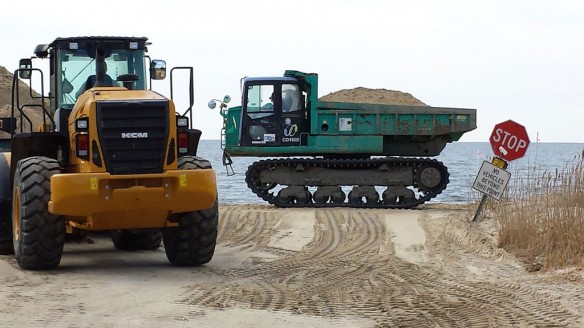
Bringing in sand to replenish beach that was eroded by Hurricane Sandy, at Kimbles Beach, New Jersey. Captions And Photo source: ©© USFWS
Excerpts;
When Superstorm Sandy rolled over the Jersey shore, it washed away some 20 million cubic yards of beach sand. Replacing that resource is not optional, many believe, because decimated beaches kill tourism economies and leave coastal areas more vulnerable to damage from the next storm.
So where does the sand come from to replenish, or “nourish” those beaches? In the future, it may come from the ocean floor.
Sand and gravel extraction in the federally regulated waters three miles offshore is emerging as an issue that is both potentially threatening to the ecosystems on the ocean floor and potentially a boon for the urgent need to rebuild beaches.
After Superstorm Sandy, states are again scrambling for sand, Fugate said, and the feds are helping them find it. The Bureau of Ocean Energy Management—or BOEM—is awarding $10 million to 13 states,to map and identify sand and gravel in federal waters, he said…
Read Full Article, Working Waterfront / Island Institute
A Beach Project Built on Sand; By Robert S. Young, PhD; in The New York Times (09-22-2014)
Earlier this month, Gov. Andrew M. Cuomo announced a $207 million plan to dredge millions of tons of sand off the south shore of Long Island and spread it along the beaches and dunes. It is a colossal waste of money and another consequence of the nation’s failure to develop a coherent plan to address the risks from storms faced by states along the eastern seaboard and gulf coast…
Coastal Erosion Sparks ‘Sand Wars’ In New England, WGBH News
Sand, Rarer Than One Thinks: A UNEP report
Sand and gravel are mined world-wide and account for the largest volume of solid material extracted globally. Formed by erosive processes over thousands of years (John, 2009), they are now being extracted at a rate far greater than their renewal. Furthermore, the volume being extracted is having a major impact on rivers, deltas and coastal and marine ecosystems (Figure 1), results in loss of land through river or coastal erosion, lowering of the water table and decreases in the amount of sediment supply. Despite the colossal quantities of sand and gravel being used, our increasing dependence on them and the significant impact that their extraction has on the environment, this issue has been mostly ignored by policy makers and remains largely unknown by the general public.
Sand Wars, An Investigation Documentary, By Denis Delestrac
Is beach sand an infinite resource? Can the existing supply satisfy a gigantic demand fueled by construction booms? What are the consequences of intensive beach sand mining for the environment and the neighboring populations…? This investigation takes us around the globe to unveil a new gold rush and a disturbing fact: the “Sand Wars” have begun.
We Need to Retreat From the Beach, An Op Ed by Orrin H. Pilkey.
As ocean waters warm, the Northeast is likely to face more Sandy-like storms. And as sea levels continue to rise, the surges of these future storms will be higher and even more deadly. We can’t stop these powerful storms. But we can reduce the deaths and damage they cause…









